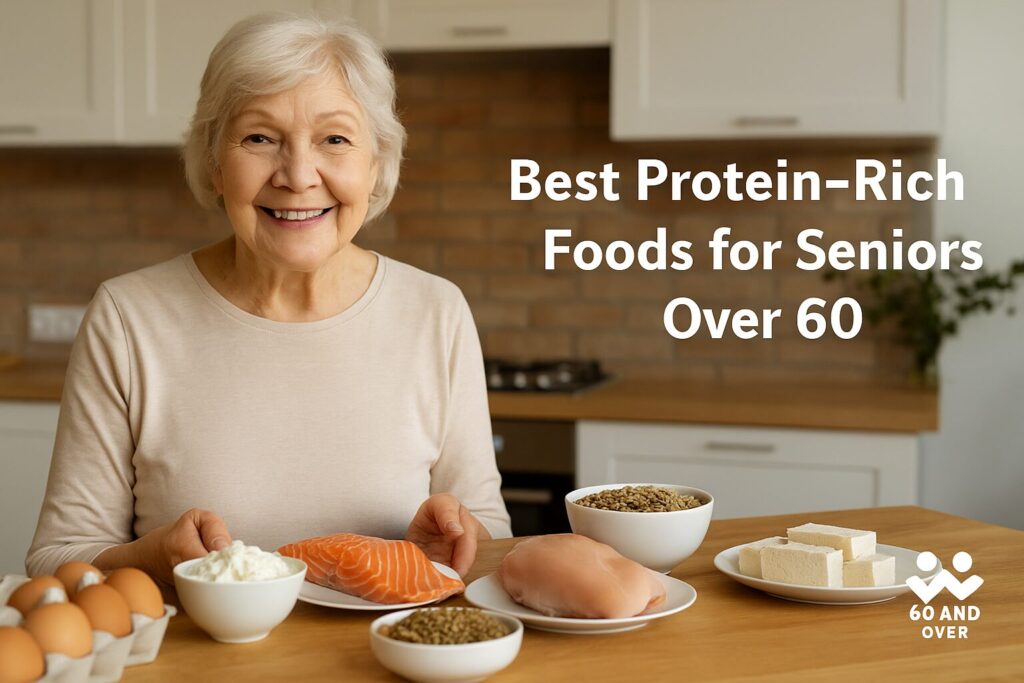A simple guide to boosting strength, preserving muscle, and staying full with the right foods
As we get older, our bodies change — and so do our nutritional needs. One of the most overlooked yet essential nutrients for adults over 60 is protein. Why? Because protein is the foundation of muscle, bone strength, immune support, and energy.
And after 60, the body becomes less efficient at processing and using protein, meaning you need more of it — not less.
If you’re wondering what to eat and how much, this guide walks you through the best protein-rich foods for seniors over 60, including how to include them in your day, even if you’re not a big eater.
🧠 Why Seniors Need More Protein (Not Less)
Let’s break it down:
- After 60, muscle loss accelerates (called sarcopenia)
- Protein helps slow or reverse this muscle loss
- It keeps you stronger, steadier, and less prone to falls
- It supports wound healing and a healthy immune system
- It helps you feel full longer, which supports healthy weight
👉 Experts recommend adults over 60 consume at least 1.0 to 1.2 grams of protein per kilogram of body weight daily — that’s about 65–90 grams per day for most women and men.
🥚 1. Eggs
Protein per large egg: ~6 grams
Eggs are a nutritional powerhouse — affordable, easy to digest, and incredibly versatile. Scrambled, hard-boiled, poached — any way you cook them, they deliver complete protein with all nine essential amino acids.
How to use them:
- Add boiled eggs to salads
- Make veggie-loaded omelets
- Blend into breakfast wraps
👉 Bonus: Eggs also contain choline, which supports brain health.
🍗 2. Chicken Breast
Protein per 3 oz cooked: ~26 grams
Skinless chicken breast is low in fat, high in protein, and easy to prepare in bulk. For those who eat meat, it’s one of the best lean sources.
How to use it:
- Bake or grill and slice over salads
- Add to soups or stir-fry with veggies
- Shred for sandwiches or wraps
🧀 3. Cottage Cheese
Protein per ½ cup: ~14 grams
Cottage cheese is soft, easy to chew, and surprisingly high in protein. It’s ideal for seniors with dental concerns or low appetite.
How to use it:
- Eat plain or topped with fruit
- Mix into smoothies
- Serve on whole grain toast with tomatoes
👉 Low-sodium versions are best for heart health.
🥜 4. Greek Yogurt
Protein per ¾ cup (plain): ~15–20 grams
Thicker than regular yogurt and loaded with protein, Greek yogurt also delivers calcium and probiotics for gut health.
How to use it:
- Breakfast with berries and flaxseed
- As a creamy base for dips or sauces
- Swapped in place of sour cream
👉 Look for: Unsweetened or low-sugar versions.
🐟 5. Salmon (and Fatty Fish)
Protein per 3 oz cooked: ~22 grams
Salmon provides not only protein but also omega-3 fatty acids, which reduce inflammation and support brain and heart health.
How to use it:
- Baked or pan-seared for dinner
- Added cold to a salad
- Canned salmon in sandwiches or patties
👉 Bonus: Sardines, mackerel, and trout are great alternatives.
👉👉Get Salmon delivered to your home today (fast delivery)
🌱 6. Lentils and Beans
Protein per 1 cup cooked lentils: ~18 grams
Protein per 1 cup cooked black beans: ~15 grams
Plant-based, fiber-rich, and filling — lentils and beans are fantastic meat alternatives. They’re also great for cholesterol and blood sugar control.
How to use them:
- Lentil soup or chili
- Black bean tacos
- Chickpea salad
👉 Soaking or rinsing canned versions reduces gas and sodium.
🥛 7. Milk (Dairy or Fortified Alternatives)
Protein per 1 cup dairy milk: ~8 grams
Protein per 1 cup soy milk: ~7 grams
Milk adds a quick boost of protein and calcium. If you’re lactose intolerant, go for unsweetened fortified soy milk — the most protein-rich plant-based alternative.
How to use it:
- With cereal or oatmeal
- In smoothies
- In cooking and baking
🧃 8. Protein Shakes or Powders
Protein per serving: ~15–25 grams
If you struggle to get enough protein through food alone, protein powders can fill the gap. Look for whey, pea, or collagen-based options.
How to use them:
- Blend into smoothies
- Mix with milk or water
- Use in pancake or muffin recipes
👉 Pro tip: Choose shakes without added sugars or fillers.
🧾 9. Tofu and Tempeh
Protein per 3 oz tofu: ~9 grams
Protein per 3 oz tempeh: ~16 grams
Excellent for vegetarians, tofu and tempeh are soy-based proteins that absorb flavors well and can be cooked in many ways.
How to use them:
- Stir-fry with veggies
- Grill or bake
- Add to rice bowls or soups
🥩 10. Lean Ground Turkey or Beef
Protein per 3 oz cooked: ~22 grams
Lean cuts of red meat can still be part of a healthy diet, especially when portioned and paired with vegetables and whole grains.
How to use them:
- Turkey meatballs
- Beef and veggie stir-fry
- Taco night with whole grain tortillas
🚀👉Get Lean Ground Turkey delivered to your home today.
🧠 How to Add More Protein Without Overeating
If your appetite isn’t what it used to be, here are some tips:
- Add protein to every meal, even snacks
- Use nut butters on toast, apples, or crackers
- Cook quinoa or beans into soups and stews
- Keep hard-boiled eggs or Greek yogurt on hand
- Split protein shakes into small servings throughout the day
📌 Final Takeaway: Make Protein a Priority Daily
You don’t need to overhaul your diet overnight. Just start by adding one protein-rich food to each meal, and work from there. Over time, you’ll feel stronger, more energized, and better equipped to stay independent and active.





